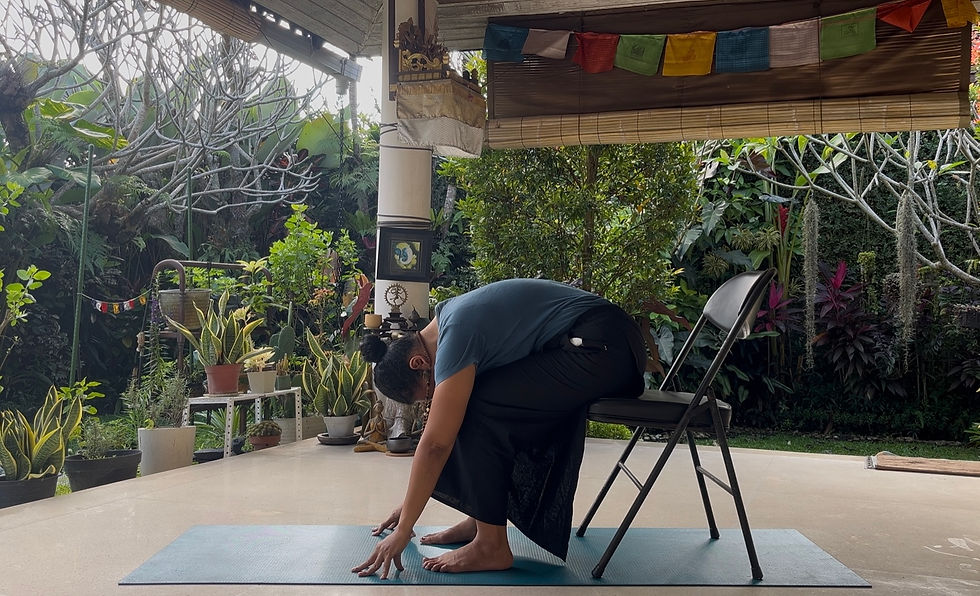Uttanasana | Standing Forward Bend
- Yoga Ria Bali
- Sep 11
- 3 min read

Mythology of Uttanasana
Uttanasana comes from the Sanskrit words:
Ut – intense or powerful
Tan – to stretch or extend
Asana – posture or seat
While not tied to a specific myth, Uttanasana embodies the yogic principle of surrender and humility. In ancient yogic teachings, forward bends represent the act of bowing to the divine—offering one’s ego, thoughts, and burdens in return for clarity and peace. This pose is seen as a symbol of devotion, introspection, and letting go, much like the sages and seekers of truth who bowed in prayer and meditation in pursuit of spiritual insight.

How to do Uttanasana (Standing Forward Bend)
Start in Tadasana (Mountain Pose): Stand tall with feet hip-width apart, grounding evenly through both feet.
Inhale and Lengthen: Raise your arms overhead and lengthen through the spine.
Exhale and Fold Forward: Hinge at the hips (not the waist) and fold forward over your legs, keeping a slight bend in the knees if needed.
Hands Placement: Let your hands rest on the floor beside your feet, or on your shins, ankles, or blocks if you can’t reach the floor comfortably.
Relax the Head , Jaw and Neck: Let the head hang heavy, and soften the jaw, neck, and eyes.
Stay and Breathe: Hold the pose for 5–10 deep breaths. Focus on the length of the spine and the softness of the exhale.
To Come Up: Bend your knees slightly, engage your core, and slowly roll up to standing on an inhale.

Using Props in Uttanasana
Yoga Blocks:
Place blocks under your hands to support your spine if your hamstrings are tight.
Wall Support:
Perform the pose with your back close to a wall for support and grounding.
Chair Forward Fold:
If standing is difficult, sit on a chair and fold forward over your legs, resting your hands on a table or blocks.
Blanket Under Heels:
For tight calves or hamstrings, placing a rolled blanket under the heels can reduce strain and help balance.
Benefits of Uttanasana
Stretches the Hamstrings and Calves: Improves flexibility in the back body.
Relieves Tension in the Spine: Gently decompresses the vertebrae and relaxes the lower back.
Calms the Nervous System: Encourages parasympathetic activation, reducing stress and anxiety.
Improves Digestion: The gentle compression of the abdomen stimulates digestive organs.
Boosts Blood Flow to the Brain: Inversion promotes circulation and mental clarity.
Relieves Mild Headaches and Insomnia: Through relaxation and nervous system regulation.
Grounds and Centers the Mind: Brings awareness inward, enhancing mindfulness and presence.


Disclaimer
Avoid this pose if you have a recent back injury, disc issues, or unregulated high blood pressure.
Individuals with vertigo or glaucoma should modify or avoid the full inversion.
Those with tight hamstrings or hips should keep the knees slightly bent to avoid overstretching.
Pregnant practitioners should practice a wide-legged forward fold or avoid deep compression.
Always warm up before practicing deep forward bends to protect the spine and hamstrings.
The Role of Uttanasana in Well-Being
Uttanasana reminds us to let go—of tension, of ego, of mental clutter. By folding inward, we symbolically turn our focus from the external to the internal. This posture teaches humility, grounding, and self-reflection, creating space for emotional release and clarity. Regular practice helps reduce stress and cultivates a calm, centered state of mind—essential for navigating daily life with grace.

Affirmation for Uttanasana
“I release what no longer serves me. I bow inward with peace, patience, and trust.”
Practicing Uttanasana helps harmonize the body and mind, making it a powerful pose for both physical release and emotional renewal.




Comments